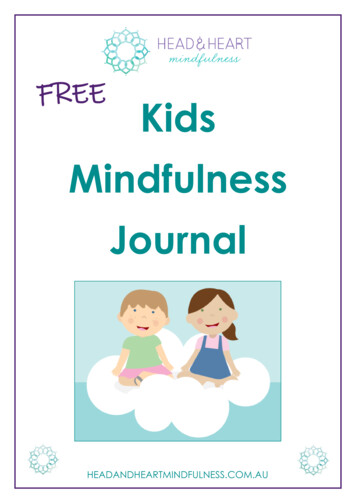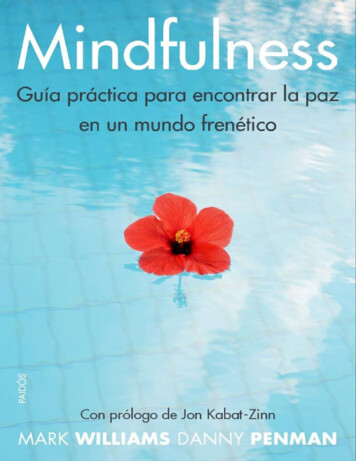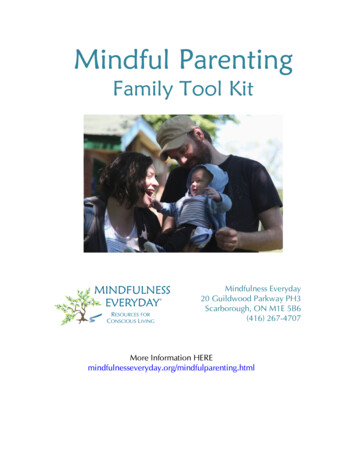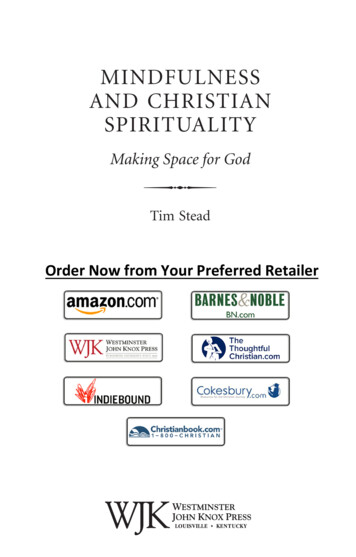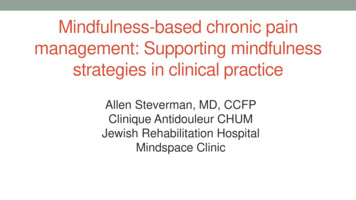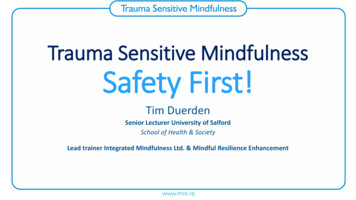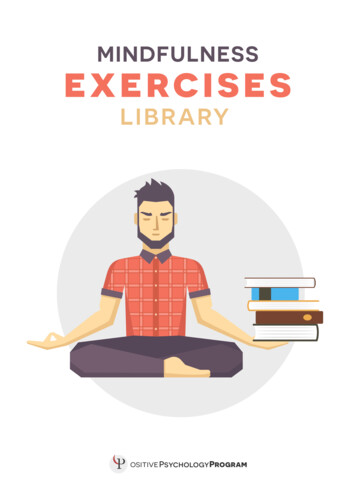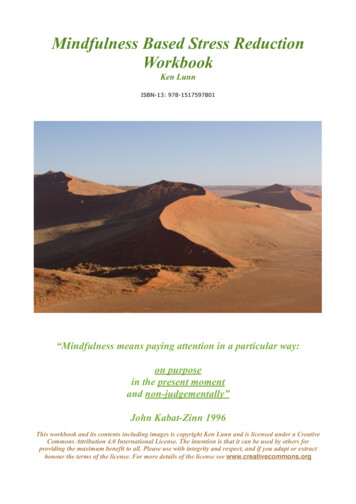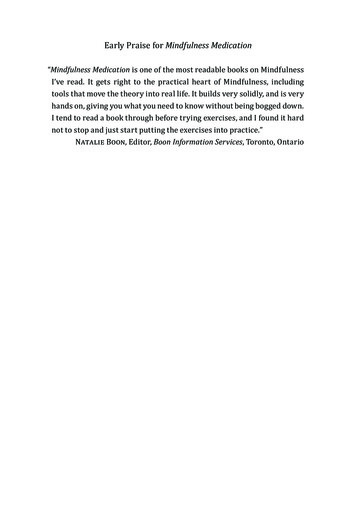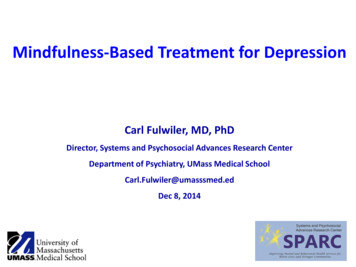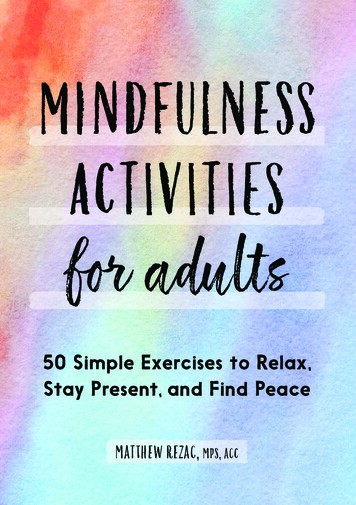
Transcription
TIONJOYvi6789ResourcesReferences111113
YOUR BEAUTIFUL BREATHPLAYER: 1 TIME: 5 MINUTESThe breath is a handy tool for cultivating mindfulness. You take itwith you wherever you go. It provides an always present, repeating cycle that’s perfect for anchoring awareness: inhale, pause,exhale, pause. Yet no two breaths are exactly alike. Sometimes,the breath is choppy and shallow. Other times, it is deep anddrawn out. Through challenges and calm, we keep moving forward, just like the breath. This activity cultivates awareness ofyour simple, life-giving, beautiful breath.1. Find a comfortable, alert position with your eyes open or closed.2. Bring awareness to your breath. Notice where and when you arefirst aware of the breath cycle. Most of us might point to the nostrils, during inhalation, as the “starting point” of the breath cycle.But is this really where and when the breath begins?3. Now bring more awareness to the air going in and out at yournostrils. How much sensation can you experience there? Explorethese questions:J How fast is the air moving?J What temperature is the air?is the temperature different between when you exhaleJ Howand inhale?J Where on your nostrils can you first feel the air?J Where inside your nostrils does the sensation seem to end?2M I n d f u L n E s s Ac T I V I T I E s f o r A d u LT s
4. Next, bring your awareness to the top of your throat, just behindyour mouth. What does the breath feel like at this point inits journey?5. Now move your awareness to the breath as it moves in and outof your throat between the head and body. During the pausebetween inhale and exhale, does the breath remain insideyour throat?6. Next, shift awareness to the breath in your chest. Can you feelyour lungs and rib cage expanding and contracting? How wouldyou describe the quantity of air that fills your lungs?7. Finally, notice the breath at your diaphragm and into your belly.How deep does your breath go? Can you bring more air into thedeepest part of the belly?A STORM NEVER HURT THE SKY.B r E AT H3
THE ORBIT OF AWARENESSPLAYER: 1 TIME: 5 MINUTESDo you know where your awareness is located? Most of usexperience awareness as being just behind our eyes. We mightthink of consciousness as being in our brain and that our awareness looks out from the eyes. It can seem that awareness andthoughts are the same thing. Actually, we can move our awareness with great agility. In this activity, you’ll practice movingyour awareness, which can help you see that you are more thanyour thoughts.1. Sit comfortably and close your eyes. Place your feet securely onthe floor, sit up a little straighter, and take a few calming breaths.2. Once you’re settled, bring your awareness to the space behindyour head, just above your neck. This will be similar to feeling thepresence of someone behind you. Simply tune your awareness into that “what’s behind you” type of knowing.3. Now gently and slowly move your awareness forward along bothsides of your head.4. Continue moving your awareness forward along both sides untilyou reach the edges of your peripheral vision. It will be approximately just behind your temples.5. Keep your awareness there for a moment. Observe the uniqueexperience of being aware of what’s just beyond the edge of yourfield of vision.24M I n d f u L n E s s Ac T I V I T I E s f o r A d u LT s
6. When you’re ready, continue to move your awareness forwardaround both sides of your head. Continue until the awarenesscoming from the left meets the awareness coming from the rightin front of your head. As awareness meets awareness, you realizeyou’ve been holding awareness in two locations at once. Kind ofweird. Kind of cool!7. Finally, hold the full orbit you just completed in your awareness.Be aware of the entire ring of space around your head at once.Relax into this full-orbit awareness for as long as you like.8. Congrats! You moved awareness outside of your thinking mind.Where else might you take it?I CHOOSE AND CREATE MY INNER EXPERIENCE.MInd25
BELLY LOvEPLAYER: 1 TIME: 10 MINUTESTake a moment to consider what the belly does for us. It digestsfood and creates energy, and we rely on its “gut instincts” tomake important choices. But we rarely offer back the care andattention our bellies deserve. In fact, the belly is often wherestress accumulates. Stress can lead to uncomfortable stomachsensations like tightness, twisting, and nausea. Meditationteacher Roshi Joan Halifax teaches the importance of having astrong back and a soft belly: A wholehearted life requires bothinner confidence (a strong back) and vulnerability (a soft belly).This activity gives you a chance to relax your belly and mindfullynurture your ability to meet the world with love and openness.1. Lie comfortably on your back or side. Close your eyes. Visualizeany tension dissolving into the surface beneath you.2. Place your hands tenderly on your belly, as though resting yourhand on an infant or pet. Feel the rise and fall of your belly asyou breathe.3. Shift awareness to the space within your belly. Note what yousense there. For example, there may be tightness, gurgling,pressure, or a simple sense of space.4. Check for any remaining tightness. Take a deep breath, then pushall the air out. Allow your belly to be completely loose and supple,with nothing but gravity holding it.50M I n d f u L n E s s Ac T I V I T I E s f o r A d u LT s
5. Connect with the internal associations you have with your belly.What memories come to the surface? What emotions are linkedwith it? What does your belly remind you of?6. Notice whether the associations have positive, negative, or neutral undertones. When you notice a negative connotation, offeryour belly acknowledgment and appreciation. For example, youmight say, “I see you are burdened with criticism for being flabby.I appreciate that you hold my stress when I don’t know where elseto put it.”7. Rub your hands over your belly compassionately. Allow yourselfto feel tenderly comforted by your own loving touch.8. Finally, imagine your belly as a source of openhearted energy.What does it feel like to let your belly be open and loving?How can you express this energy in daily life?I SPEAK TO BE UNDERSTOOD.B o dY51
HOLD THE PHONE!PLAYER: 1 TIME: 5 MINUTESTechnology lets us communicate with just about anyoneinstantaneously, but it can also make us feel distracted anddisconnected from those nearest to us. For many people, technology has become an addiction. We check for social mediaupdates every few minutes. We get lost in long periods of websurfing. Often, we use technology to escape from discomfortor boredom, but we can choose to stay with the uncomfortableexperience instead. This quick meditation uses mindful awareness to help you reconnect with yourself and create a healthierrelationship with technology.1. Be on the lookout for an urge to use technology. If you’re like mostof us, you won’t have to wait long!2. When you feel the urge to grab your smartphone or tablet, pause.Pausing just a moment is great progress. You are bringing awareness to an autopilot process.3. Now, do the following: Take one deep breath, saying, “With thisbreath, I see my tech habit wants to launch.” On the exhalation,say, “Breathing out, I will choose whether to continue the habit.”The importance of this step is to train yourself to see the decisionpoint where you have power.4. During the next urge, say, “This time, I choose to fully experiencethe urge before using my phone.”70M I n d f u L n E s s Ac T I V I T I E s f o r A d u LT s
5. Bring direct awareness to your experience of the urge. Start withthe physical sensations present in your body. Look for things liketightness in your belly, nervous energy in your chest, or a clenchedjaw. Now consider what emotions are present. Do you feel anxiety, anger, or annoyance? Take two minutes to simply feel theseuncomfortable feelings.6. After two minutes, notice how the sensations and emotions havedissipated to some extent. Ask yourself, “Do I still want to usetechnology as an escape now, or do something else?” It’s fine ifyou still want to use your phone or tablet, of course, but now youhave put the decision to do so in your own hands.WHEN I NEED TO WAIT, I SMILE.co n n E c T I o n71
A CUP OF JOYPLAYER: 1 TIME: 5 TO 10 MINUTESSUPPLIES: YOUR FAVORITE MORNING DRINKIt’s easy to spend your entire life waiting for the next best thing.As teens, we can’t wait to become adults. Then we wait for jobswe like. Then it’s waiting to have enough money for a home orfamily. Along the way, we wait for promotions, vacations, the rightrelationships, and other milestones. The only people who seemto not be waiting are young children, who are better able to abidein the present moment. And they seem to have more fun, too!With mindfulness, we don’t need to wait for joyful experiencesbecause they’re available to us all the time. This simple activity isabout creating joy in everyday activities.1. Prepare to make your favorite morning drink, such as coffee, tea,or a smoothie.2. Arrange the ingredients on your countertop. Take great care as ifyou’re displaying them for an esteemed guest.3. Moving at a gentle pace, notice small, sensory details, such asthe curve and temperature of your cup and the distribution of aspoon’s weight in your hand.4. Begin preparing the drink. Note the sounds of liquid pouringinto metal, glass, or earthenware. Pay attention to every textureyou touch. Inhale the aromas of your tea bag, coffee grounds, orother ingredients.94M I n d f u L n E s s Ac T I V I T I E s f o r A d u LT s
5. Once your drink is ready, sit down and set the drink in front ofyou. Look at the shadows cast across your cup or glass. Noticethe colors of the liquid, the cup, and the table. Observe the liquid’s surface—are there bubbles or movement? Is it creamyor translucent?6. Close your eyes. Spend a minute smelling your drink. Switchbetween actively inhaling the aroma and passively allowing thescent to drift into your nostrils. Feel the temperature of your drinkas you hover above it.7. Take a sip. Immerse yourself in the sensations: the heat or cold,how it feels across your tongue and going down your throat, andthe flavor it leaves in your mouth.8. Continue to enjoy your drink with mindfulness. Notice the heightened sensations. Appreciate the joy that comes from nurturingthese simple sensory pleasures.I PRACTICE “ENOUGHNESS.”J oY95
PLAYER: 1 TIME: 5 MINUTES The breath is a handy tool for cultivating mindfulness. You take it with you wherever you go. It provides an always present, repeat-ing cycle that’s perfect for anchoring awareness: inhale, pause, exhale, pause. Yet no two breaths are exactly alike. Sometimes,
